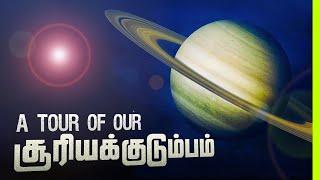
சூரியக்குடும்பம் ஒரு சுற்றுலா | Tour of our Solar System in Tamil
Our Earth is unique in this universe. But our every day activities continually destroy it making it difficult for our children and their children to survive in the future. To truly understand its beauty, we must understand how unique earth is in our solar system.
The principal component of the Solar System is the Sun, a G2 main-sequence star that contains 99.86% of the system's known mass and dominates it gravitationally. The Sun's four largest orbiting bodies, the giant planets, account for 99% of the remaining mass, with Jupiter and Saturn together comprising more than 90%. The remaining objects of the Solar System (including the four terrestrial planets, the dwarf planets, moons, asteroids, and comets) together comprise less than 0.002% of the Solar System's total mass.
Most large objects in orbit around the Sun lie near the plane of Earth's orbit, known as the ecliptic. The planets are very close to the ecliptic, whereas comets and Kuiper belt objects are frequently at significantly greater angles to it. As a result of the formation of the Solar System planets, and most other objects, orbit the Sun in the same direction that the Sun is rotating (counter-clockwise, as viewed from above Earth's north pole). There are exceptions, such as Halley's Comet. Most of the larger moons orbit their planets in this prograde direction (with Triton being the largest retrograde exception) and most larger objects rotate themselves in the same direction (with Venus being a notable retrograde exception).
The overall structure of the charted regions of the Solar System consists of the Sun, four relatively small inner planets surrounded by a belt of mostly rocky asteroids, and four giant planets surrounded by the Kuiper belt of mostly icy objects. Astronomers sometimes informally divide this structure into separate regions. The inner Solar System includes the four terrestrial planets and the asteroid belt. The outer Solar System is beyond the asteroids, including the four giant planets. Since the discovery of the Kuiper belt, the outermost parts of the Solar System are considered a distinct region consisting of the objects beyond Neptune.
Most of the planets in the Solar System have secondary systems of their own, being orbited by planetary objects called natural satellites, or moons (two of which, Titan and Ganymede, are larger than the planet Mercury), and, in the case of the four giant planets, by planetary rings, thin bands of tiny particles that orbit them in unison. Most of the largest natural satellites are in synchronous rotation, with one face permanently turned toward their parent.
All planets of the Solar System lie very close to the ecliptic. The closer they are to the Sun, the faster they travel (inner planets on the left, all planets except Neptune on the right).
Kepler's laws of planetary motion describe the orbits of objects about the Sun. Following Kepler's laws, each object travels along an ellipse with the Sun at one focus. Objects closer to the Sun (with smaller semi-major axes) travel more quickly because they are more affected by the Sun's gravity. On an elliptical orbit, a body's distance from the Sun varies over the course of its year. A body's closest approach to the Sun is called its perihelion, whereas its most distant point from the Sun is called its aphelion. The orbits of the planets are nearly circular, but many comets, asteroids, and Kuiper belt objects follow highly elliptical orbits. The positions of the bodies in the Solar System can be predicted using numerical models.
Although the Sun dominates the system by mass, it accounts for only about 2% of the angular momentum. The planets, dominated by Jupiter, account for most of the rest of the angular momentum due to the combination of their mass, orbit, and distance from the Sun, with a possibly significant contribution from comets.
The Sun, which comprises nearly all the matter in the Solar System, is composed of roughly 98% hydrogen and helium. Jupiter and Saturn, which comprise nearly all the remaining matter, are also primarily composed of hydrogen and helium. A composition gradient exists in the Solar System, created by heat and light pressure from the Sun; those objects closer to the Sun, which are more affected by heat and light pressure, are composed of elements with high melting points. Objects farther from the Sun are composed largely of materials with lower melting points. The boundary in the Solar System beyond which those volatile substances could condense is known as the frost line, and it lies at roughly 5 AU from the Sun.
The principal component of the Solar System is the Sun, a G2 main-sequence star that contains 99.86% of the system's known mass and dominates it gravitationally. The Sun's four largest orbiting bodies, the giant planets, account for 99% of the remaining mass, with Jupiter and Saturn together comprising more than 90%. The remaining objects of the Solar System (including the four terrestrial planets, the dwarf planets, moons, asteroids, and comets) together comprise less than 0.002% of the Solar System's total mass.
Most large objects in orbit around the Sun lie near the plane of Earth's orbit, known as the ecliptic. The planets are very close to the ecliptic, whereas comets and Kuiper belt objects are frequently at significantly greater angles to it. As a result of the formation of the Solar System planets, and most other objects, orbit the Sun in the same direction that the Sun is rotating (counter-clockwise, as viewed from above Earth's north pole). There are exceptions, such as Halley's Comet. Most of the larger moons orbit their planets in this prograde direction (with Triton being the largest retrograde exception) and most larger objects rotate themselves in the same direction (with Venus being a notable retrograde exception).
The overall structure of the charted regions of the Solar System consists of the Sun, four relatively small inner planets surrounded by a belt of mostly rocky asteroids, and four giant planets surrounded by the Kuiper belt of mostly icy objects. Astronomers sometimes informally divide this structure into separate regions. The inner Solar System includes the four terrestrial planets and the asteroid belt. The outer Solar System is beyond the asteroids, including the four giant planets. Since the discovery of the Kuiper belt, the outermost parts of the Solar System are considered a distinct region consisting of the objects beyond Neptune.
Most of the planets in the Solar System have secondary systems of their own, being orbited by planetary objects called natural satellites, or moons (two of which, Titan and Ganymede, are larger than the planet Mercury), and, in the case of the four giant planets, by planetary rings, thin bands of tiny particles that orbit them in unison. Most of the largest natural satellites are in synchronous rotation, with one face permanently turned toward their parent.
All planets of the Solar System lie very close to the ecliptic. The closer they are to the Sun, the faster they travel (inner planets on the left, all planets except Neptune on the right).
Kepler's laws of planetary motion describe the orbits of objects about the Sun. Following Kepler's laws, each object travels along an ellipse with the Sun at one focus. Objects closer to the Sun (with smaller semi-major axes) travel more quickly because they are more affected by the Sun's gravity. On an elliptical orbit, a body's distance from the Sun varies over the course of its year. A body's closest approach to the Sun is called its perihelion, whereas its most distant point from the Sun is called its aphelion. The orbits of the planets are nearly circular, but many comets, asteroids, and Kuiper belt objects follow highly elliptical orbits. The positions of the bodies in the Solar System can be predicted using numerical models.
Although the Sun dominates the system by mass, it accounts for only about 2% of the angular momentum. The planets, dominated by Jupiter, account for most of the rest of the angular momentum due to the combination of their mass, orbit, and distance from the Sun, with a possibly significant contribution from comets.
The Sun, which comprises nearly all the matter in the Solar System, is composed of roughly 98% hydrogen and helium. Jupiter and Saturn, which comprise nearly all the remaining matter, are also primarily composed of hydrogen and helium. A composition gradient exists in the Solar System, created by heat and light pressure from the Sun; those objects closer to the Sun, which are more affected by heat and light pressure, are composed of elements with high melting points. Objects farther from the Sun are composed largely of materials with lower melting points. The boundary in the Solar System beyond which those volatile substances could condense is known as the frost line, and it lies at roughly 5 AU from the Sun.
Тэги:
#solar_system #tour #vaanaviyal_arputhangal #சூரியக்குடும்பம் #சுற்றுலா #toor #tamil #documentary #animation #வானவியல்_அற்புதங்கள் #sun #nasa #earth #planet #venus #mars #saturn #jupiter #uranus #neptune #space_newsКомментарии:
சூரியக்குடும்பம் ஒரு சுற்றுலா | Tour of our Solar System in Tamil
Vaanaviyal Arputhangal
Official OMORI OST: Playing Forever
GornyPunner
Kot Ghulam Muhammad Package - Sindh TV News
SindhTVNews
Самые серьезные риски при покупке наследственной квартиры
Консультации по недвижимости [Сергей Заводских]
La vie en rose - arr. Szász Szabolcs
Szabolcs Szász
Esra & Ozan | Another Love (english subs)
Gosia Edits











